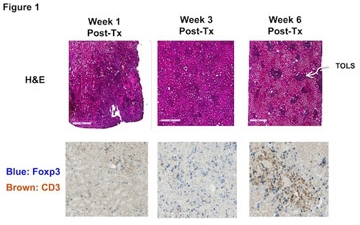Treg-Rich Organized Lymphoid Structures (TOLS) in Spontaneously Accepted Mouse Kidney Allografts.
1Center for Transplantation Sciences, Dept. of Surgery, Dept. of Pathology, Massachusetts General Hospital, Boston, MA
2University of Michigan School of Medicine, Ann Arbor, MI.
Meeting: 2016 American Transplant Congress
Abstract number: B34
Keywords: Graft acceptance, Kidney, Kidney transplantation
Session Information
Session Name: Poster Session B: Allograft Rejection, Tolerance, and Xenotransplantation
Session Type: Poster Session
Date: Sunday, June 12, 2016
Session Time: 6:00pm-7:00pm
 Presentation Time: 6:00pm-7:00pm
Presentation Time: 6:00pm-7:00pm
Location: Halls C&D
Background: In many MHC mismatched strain combinations (e.g., DBA/2 to B6) kidney allografts are spontaneously accepted without immunosuppression. This tolerance is regulatory, initially dependent Foxp3+ cells which are concentrated in the graft in distinctive periarterial structures we have termed TOLS. Depletion of Tregs causes dissolution of the TOLS and rapid onset of T cell mediated rejection.
Aim: The aim of this study is to investigate the time-course by which various immune cells infiltrate an accepted mouse kidney allografts, and which immune cells could be involved in the formation of lymphoid like structures.
Methods: DBA donor kidneys were transplanted into B6 recipients. Transplanted animals were sacrificed at week 1, 3, and 6 post-transplant. Kidney allografts were examined by H&E and immunohistochemistry was performed using antibodies to various immune cells. Cells were isolated from accepted allografts and flow cytometry was then used to quantify the percentage of Foxp3+ Tregs within the CD3+ cell population.
Results: H&E staining showed widespread infiltration of immune cells in the cortex of renal allografts at week 1, and by week 6, these various cell types were localized to TOLS (Fig. 1). IHC staining showed TOLS contain Foxp3+, CD4+, CD8+, B220+, CD11c+ and CD11b+ cells. By FACS 18.8% ± 4.4 of T cells in the TOLS at week 6 were Foxp3+. IHC showed TOLS are podoplanin positive, indicative of the presence of lymphatics, but are MECA-79 negative, a marker for high endothelial structures (HEV). Similar TOLS with abundant Foxp3+ cells were seen in accepted kidney allografts from nonhuman primates (NHP).
Conclusion: TOLS are distinctive structures in accepted kidney allografts in mice and NHP, that lack HEV, have abundant Foxp3+ cells and an admixture of T and B cells, in contrast to tertiary lymphoid organs arising from chronic inflammation. We propose that TOLS may be an intragraft marker and perhaps mediator of regulatory tolerance.

CITATION INFORMATION: Yang C, Farkash E, Ndishabandi D, White R, Jiang B, Aljabban I, Russell P, Madsen J, Colvin R, Alessandrini A. Treg-Rich Organized Lymphoid Structures (TOLS) in Spontaneously Accepted Mouse Kidney Allografts. Am J Transplant. 2016;16 (suppl 3).
To cite this abstract in AMA style:
Yang C, Farkash E, Ndishabandi D, White R, Jiang B, Aljabban I, Russell P, Madsen J, Colvin R, Alessandrini A. Treg-Rich Organized Lymphoid Structures (TOLS) in Spontaneously Accepted Mouse Kidney Allografts. [abstract]. Am J Transplant. 2016; 16 (suppl 3). https://atcmeetingabstracts.com/abstract/treg-rich-organized-lymphoid-structures-tols-in-spontaneously-accepted-mouse-kidney-allografts/. Accessed December 13, 2025.« Back to 2016 American Transplant Congress
